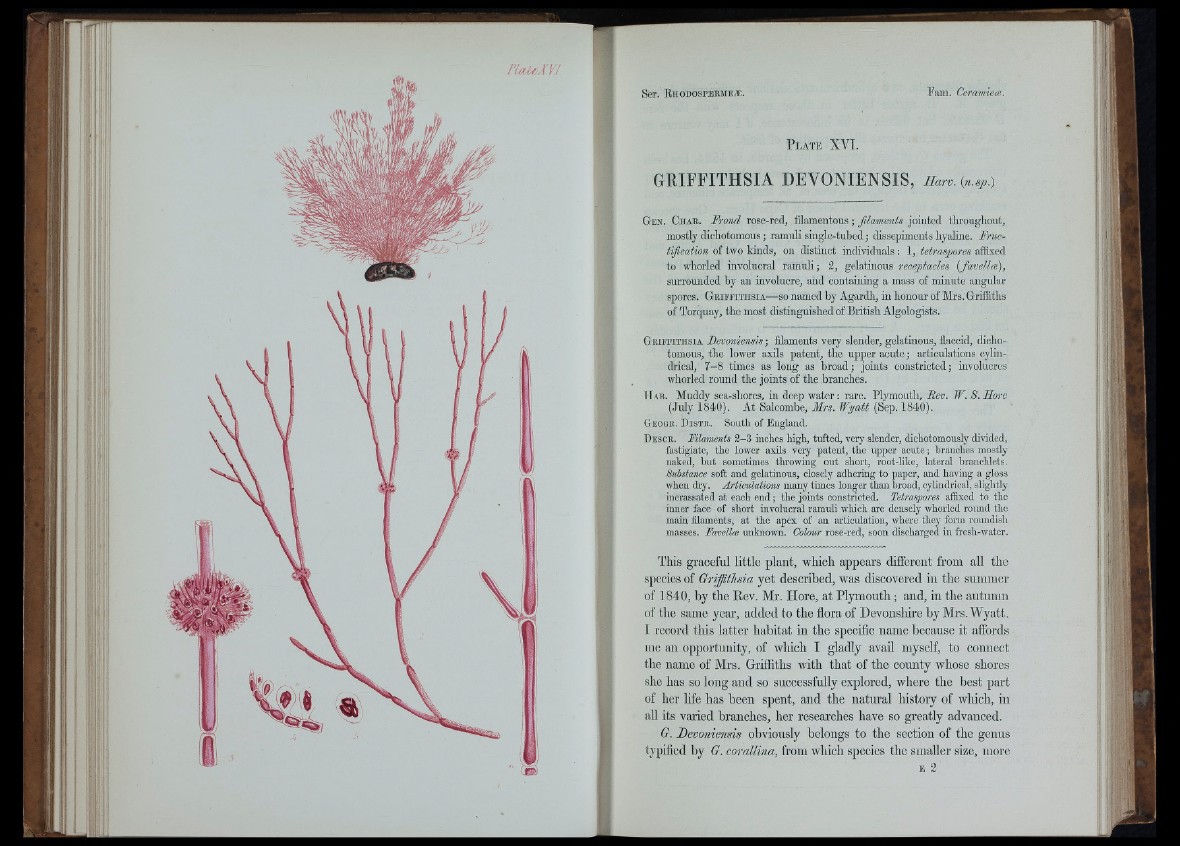
P L o iH À 'V l
P l a t e XVI.
GRIFFITHSIA DEVONIENSIS, Harv. {n.sp.)
Gen. Char. Frond rose-red, filamentous; filam en ts jointed tluoughout,
mostly dichotomous; ramuli single-tubed; dissepiments hyaline. Fructification
of two kinds, on distinct in d iv id u a ls: 1, tetraspores affixed
to whorled involuoral ram u li; 2, gelatinous receptacles { fa v e lla ),
surrounded by an involucre, and containing a mass of minute angular
spores. Gbieeithsia—^so named by Agardh, in honour of M rs. Griffiths
of Torquay, th e most distinguished of B ritish Algologists.
Gbieeithsia Bevoniensis ; filaments very slender, gelatinous, flaccid, dichotomous,
th e lower axüs patent, th e upper a cu te ; articulations cylindrical,
7 - 8 times as long as b ro a d ; joints constricted; involucres
wdiorled round th e join ts of th e branches.
Hab. Muddy sea-sliores, in deep water : rare. Plymouth, B ev. W. S. Hare
(July 1 8 4 0 ). A t Salcombe, M rs. W ya tt (Sep. 1840).
G e o g r . D i s t r . South o f England.
D e s c r . Filaments 2 -3 inches high, tufted, very slender, dichotomously divided,
fastigiate, the lower axUs very patent, the upper acute ; branches mostly
naked, hut sometimes tlmowing out short, root-like, lateral branchlets.
Substance soft and gelatinous, closely adhering to paper, and having a gloss
when dry. Articulations many times longer than broad, cylindrical, slightly
incrassated at each end ; the joints constricted. Tetraspores affixed to the
inner face of short involucral ramuli which are densely whorled round the
main filaments, at the apex of an articulation, where they form roundish
masses. Favellæ unknown. Colour rose-red, soon discharged in fresh-water.
This graceful little plant, which appears different from all the
species of Griffilltsia yet described, was discovered in the summer
of 1840, by the Rev. Mr. Hore, at Plymouth ; and, in the autumn
of the same year, added to the flora of Devonshire by Mrs. Wyatt.
I record this latter habitat in the specific name because it affords
me an opportunity, of which I gladly avail myself, to connect
the name of Mrs. Griffiths with that of the county whose shores
she has so long and so successfully explored, where the best part
of her life has been spent, and the natural history of which, in
aU its varied branches, her researches have so greatly advanced.
G. Devoniensis obviously belongs to the section of the genus
typified by G. corallina, from wliich species the smaller size, more
E 2